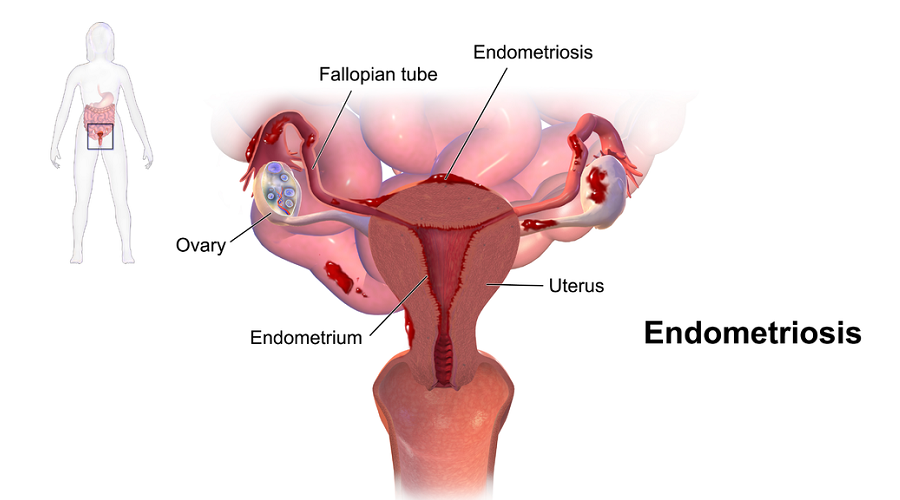Endometriosis (en-doe-me-tree-O-sis) is an often painful disorder in which tissue that normally lines the inside of your uterus — the endometrium — grows outside your uterus. Endometriosis most commonly involves your ovaries, fallopian tubes and the tissue lining your pelvis. Rarely, endometrial tissue may spread beyond pelvic organs.
With endometriosis, displaced endometrial tissue continues to act as it normally would — it thickens, breaks down and bleeds with each menstrual cycle. Because this displaced tissue has no way to exit your body, it becomes trapped. When endometriosis involves the ovaries, cysts called endometriomas may form. Surrounding tissue can become irritated, eventually developing scar tissue and adhesions — abnormal bands of fibrous tissue that can cause pelvic tissues and organs to stick to each other.
Endometriosis can cause pain — sometimes severe — especially during your period. Fertility problems also may develop. Fortunately, effective treatments are available.
Symptoms
The primary symptom of endometriosis is pelvic pain, often associated with your menstrual period. Although many women experience cramping during their menstrual period, women with endometriosis typically describe the menstrual pain that's far worse than usual. They also tend to report that the pain increases over time.
Common signs and symptoms of endometriosis may include:
- Painful periods (dysmenorrhea).Pelvic pain and cramping may begin before your period and extend several days into your period. You may also have lower back and abdominal pain.
- Pain with intercourse.Pain during or after sex is common with endometriosis.
- Pain with bowel movements or urination.You're most likely to experience these symptoms during your period.
- Excessive bleeding.You may experience occasional heavy periods (menorrhagia) or bleeding between periods (menometrorrhagia).
- Infertility.Endometriosis is first diagnosed in some women who are seeking treatment for infertility.
- Other symptoms.You may also experience fatigue, diarrhea, constipation, bloating or nausea, especially during menstrual periods.
The severity of your pain isn't necessarily a reliable indicator of the extent of the condition. Some women with mild endometriosis have intense pain, while others with advanced endometriosis may have little pain or even no pain at all.
Endometriosis is sometimes mistaken for other conditions that can cause pelvic pain, such as pelvic inflammatory disease (PID) or ovarian cysts. It may be confused with irritable bowel syndrome (IBS), a condition that causes bouts of diarrhea, constipation and abdominal cramping. IBS can accompany endometriosis, which can complicate the diagnosis.
Causes
Although the exact cause of endometriosis is not certain, possible explanations include:
- Retrograde menstruation.In retrograde menstruation, menstrual blood containing endometrial cells flows back through the fallopian tubes and into the pelvic cavity instead of out of the body. These displaced endometrial cells stick to the pelvic walls and surfaces of pelvic organs, where they grow and continue to thicken and bleed over the course of each menstrual cycle.
- Transformation of peritoneal cells.In what's known as the "induction theory," experts propose that hormones or immune factors promote a transformation of peritoneal cells — cells that line the inner side of your abdomen — into endometrial cells.
- Embryonic cell transformation.Hormones such as estrogen may transform embryonic cells — cells in the earliest stages of development — into endometrial cell implants during puberty.
- Surgical scar implantation.After a surgery, such as a hysterectomy or C-section, endometrial cells may attach to a surgical incision.
- Endometrial cells transport.The blood vessels or tissue fluid (lymphatic) system may transport endometrial cells to other parts of the body.
- Immune system disorder.It's possible that a problem with the immune system may make the body unable to recognize and destroy endometrial tissue that's growing outside the uterus.
Risk factors
Several factors place you at greater risk of developing endometriosis, such as:
- Never giving birth
- Starting your period at an early age
- Going through menopause at an older age
- Short menstrual cycles — for instance, less than 27 days
- Having higher levels of estrogen in your body or a greater lifetime exposure to estrogen your body produces
- Low body mass index
- Alcohol consumption
- One or more relatives (mother, aunt or sister) with endometriosis
- Any medical condition that prevents the normal passage of menstrual flow out of the body
- Uterine abnormalities
Endometriosis usually develops several years after the onset of menstruation (menarche). Signs and symptoms of endometriosis end temporarily with pregnancy and end permanently with menopause unless you're taking estrogen.
